MAZDA MODEL 3 HATCHBACK 2018 (in English) Owner's Manual
Manufacturer: MAZDA, Model Year: 2018, Model line: MODEL 3 HATCHBACK, Model: MAZDA MODEL 3 HATCHBACK 2018Pages: 624, PDF Size: 61.21 MB
Page 21 of 624
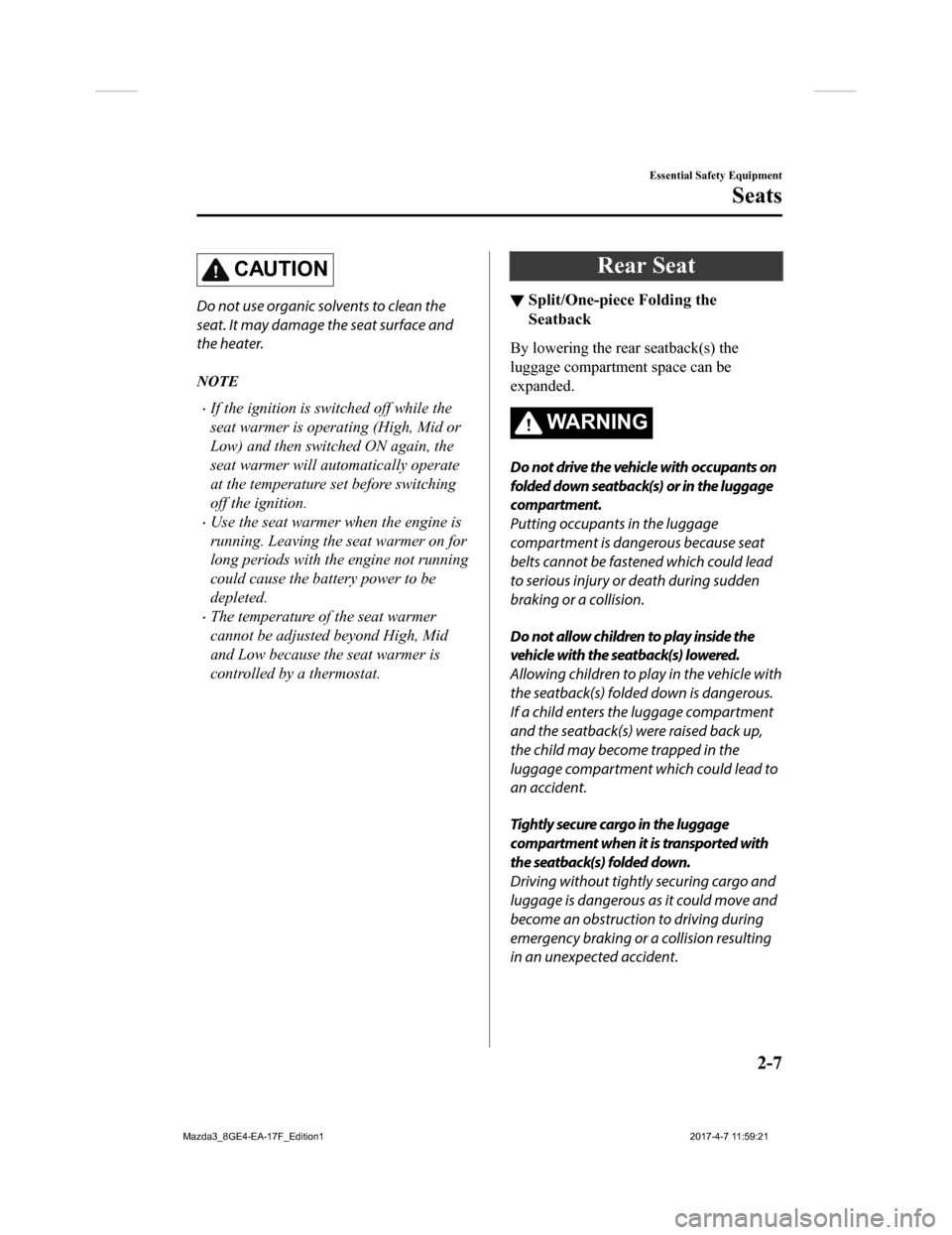
CAUTION
Do not use organic solvents to clean the
seat. It may damage the seat surface and
the heater.
NOTE
If the ignition is switched off while the
seat warmer is operating (High, Mid or
Low) and then switched ON again, the
seat warmer will automatically operate
at the temperature set before switching
off the ignition.
Use the seat warmer when the engine is
running. Leaving the seat warmer on for
long periods with the engine not running
could cause the battery power to be
depleted.
The temperature of the seat warmer
cannot be adjusted beyond High, Mid
and Low because the seat warmer is
controlled by a thermostat.
Rear Seat
▼Split/One-piece Folding the
Seatback
By lowering the rear seatback(s) the
luggage compartment space can be
expanded.
WA R N I N G
Do not drive the vehicle with occupants on
folded down seatback(s) or in the luggage
compartment.
Putting occupants in the luggage
compartment is dangerous because seat
belts cannot be fastened which could lead
to serious injury or death during sudden
braking or a collision.
Do not allow children to play inside the
vehicle with the seatback(s) lowered.
Allowing children to play in the vehicle with
the seatback(s) folded down is dangerous.
If a child enters the luggage compartment
and the seatback(s) were raised back up,
the child may become trapped in the
luggage compartment which could lead to
an accident.
Tightly secure cargo in the luggage
compartment when it is transported with
the seatback(s) folded down.
Driving without tightly securing cargo and
luggage is dangerous as it could move and
become an obstruction to driving during
emergency braking or a collision resulting
in an unexpected accident.
Essential Safety Equipment
Seats
2-7
Mazda3_8GE4-EA-17F_Edition1
2017-4-7 11:59:21
Page 22 of 624

When transporting cargo, do not allow the
cargo to exceed the height of the
seatback(s).
Transporting cargo stacked higher than the
seatback(s) is dangerous as visibility to the
rear and sides of the vehicle is reduced
which could interfere with driving
operations and lead to an accident.
Lowering the seatback(s)
CAUTION
Check the position of a front seat before
folding a rear seatback.
Depending on the position of a front seat, it
may not be possible to fold a rear seatback
all the way down because it may hit the
seatback of the front seat which could
scratch or damage the front seat or its
pocket. Lower or remove the head restraint
on the rear outboard seat if necessary.
(4–Door)
1.(Split-folding type seat)
Open the trunk lid and pull the lever of
the seatback you want to fold down.
(One-piece folding type seat)
Open the trunk lid and pull the lever of
the seatback.
*1: With split-folding
type seat only *1
2. Open a rear door and fold the rear seat
forward.
(5–Door)
Press the push knob to fold down the
seatback.
To return the seatback to its upright
position:
WA R N I N G
When returning a seatback to its upright
position, make sure the 3-point seat belt is
not caught in the seatback and the 3-point
seat belt is not twisted.
If the seat belt is used while it is twisted and
caught in the seatback, the seat belt
cannot function at its full capacity, which
could cause serious injury or death.
Essential Safety Equipment
Seats
2-8
Mazda3_8GE4-EA-17F_Edition1 2017-4-7 11:59:21
Page 23 of 624

When returning a seatback to its upright
position, make sure that it is firmly locked
and the red indication is not visible (5–
Door).
If the red indication is visible behind the
push knob, it means the seatback is not
locked. If the vehicle is driven without the
seatback locked, it could fold down
suddenly and cause an accident.
Locked position
Unlocked position Red indication
1. Make sure that the seat belt passes through the seat belt guide correctly
and it is not twisted, then raise the
seatback while preventing the seat belt
from being caught in the seatback.
(4–Door)
Seat belt guides
(5–Door)
Red indication
Seat belt guide
2. Press the seatback rearward and lock it in place. After returning the seatback
to its upright posit ion, make sure it is
securely locked.
▼ Armrest*
The rear armrest in the center of the rear
seatback can be used (no occupant in the
center seat) or placed upright.
WA R N I N G
Never put your hands and fingers around
the moving parts of the seat and armrest:
Putting your hands and fingers around the
moving parts of the seat and armrest is
dangerous as they
could get injured.
Essential Safety Equipment
Seats
*Some models.2-9
Mazda3_8GE4-EA-17F_Edition1 2017-4-7 11:59:21
Page 24 of 624

Head Restraints
Your vehicle is equipped with head
restraints on all outboard seats and the rear
center seat. The head restraints are
intended to help protect you and the
passengers from neck injury.
WA R N I N G
Always drive with the head restraints
installed when seats are being used and
make sure they are properly adjusted:
Driving with the head restraints adjusted
too low or removed is dangerous. With no
support behind your head, your neck could
be seriously injured in a collision.
Height adjustment
To raise a head restraint, pull it up to the
desired position.
To lower the head restraint, press the
stop-catch release, then push the head
restraint down.
Adjust the head restra int so that the center
is even with the top of the passenger's
ears.
Front outboard seat
Rear outboard seat
Rear center seat
Essential Safety Equipment
Seats
2-10
Mazda3_8GE4-EA-17F_Edition1 2017-4-7 11:59:21
Page 25 of 624

Removal/Installation
To remove the head restraint, pull it up
while pressing the stop-catch.
To install the head restraint, insert the legs
into the holes while pressing the
stop-catch.
WA R N I N G
Always drive with the head restraints
installed when seats are being used and
make sure they are properly installed:
Driving with the head restraints not
installed is dangerous. With no support
behind your head, your neck could be
seriously injured in a collision.
Essential Safety Equipment
Seats
2-11
Mazda3_8GE4-EA-17F_Edition1 2017-4-7 11:59:21
Page 26 of 624
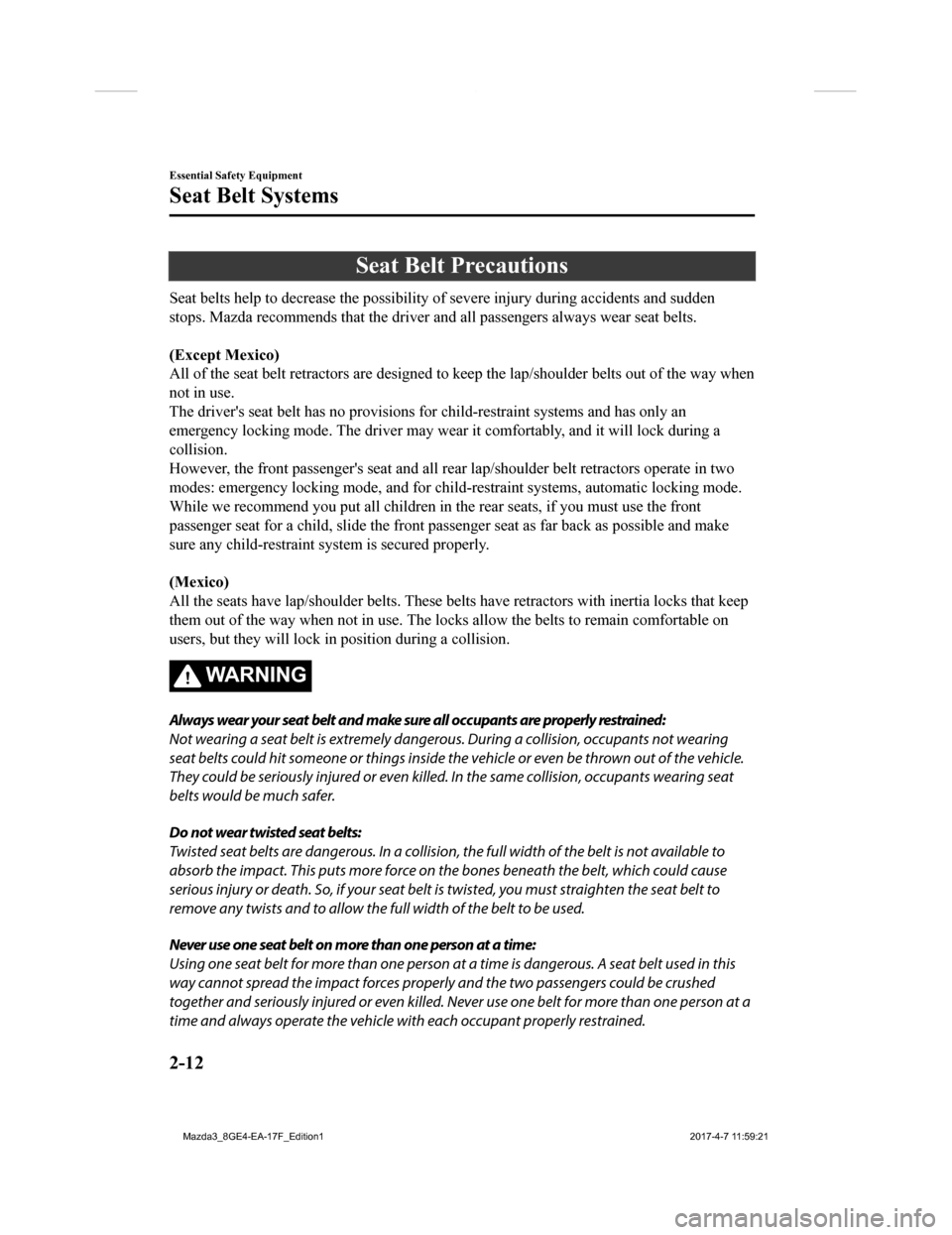
Seat Belt Precautions
Seat belts help to decrease the possibility of severe injury during accidents and sudden
stops. Mazda recommends that the driver and all passengers always wear seat belts.
(Except Mexico)
All of the seat belt retractors are designed to keep the lap/sh oulder belts out of the way when
not in use.
The driver's seat belt has no provisions for child-restraint sy stems and has only an
emergency locking mode. The driver may wear it comfortably, and it will lock during a
collision.
However, the front passenger's seat and all rear lap/shoulder b elt retractors operate in two
modes: emergency locking mode, and for child-restraint systems, automatic locking mode.
While we recommend you put all chi ldren in the rear seats, if you must use the front
passenger seat for a child, slide the front passenger seat as f ar back as possible and make
sure any child-restraint sy stem is secured properly.
(Mexico)
All the seats have lap/shoulder belts. These belts have retract ors with inertia locks that keep
them out of the way when not in use. The locks allow the belts to remain comfortable on
users, but they will lock in position during a collision.
WA R N I N G
Always wear your seat belt and make sure all occupants are properly restrained:
Not wearing a seat belt is extremely dangerou s. During a collision, occupants not wearing
seat belts could hit someone or things inside th e vehicle or even be thrown out of the vehicle.
They could be seriously injured or even killed . In the same collision, occupants wearing seat
belts would be much safer.
Do not wear twisted seat belts:
Twisted seat belts are dangerous. In a collision, the full width of the belt is not available to
absorb the impact. This puts more force on the bones beneath the belt, which could cause
serious injury or death. So, if your seat belt is twisted, you must straighten the seat belt to
remove any twists and to allow the full width of the belt to be used.
Never use one seat belt on more than one person at a time:
Using one seat belt for more than one person at a time is dangerous. A seat belt used in this
way cannot spread the impact forces properly and the two passengers could be crushed
together and seriously injured or even killed. Never use one belt for more than one person at a
time and always operate the vehicle with each occupant properly restrained.
Essential Safety Equipment
Seat Belt Systems
2-12
Mazda3_8GE4-EA-17F_Edition1 2017-4-7 11:59:21
Page 27 of 624

Do not operate a vehicle with a damaged seat belt:
Using a damaged seat belt is dangerous. An accident could damage the belt webbing of the
seat belt in use. A damaged seat belt cannot provide adequate protection in a collision. Have
an Authorized Mazda Dealer inspect all seat be lt systems in use during an accident before
they are used again.
Have your seat belts changed immediately if the pretensioner or load limiter has been
expended:
Always have an Authorized Mazda Dealer imme diately inspect the seat belt pretensioners
and air bags after any collision. Like the air ba gs, the seat belt pretensioners and load limiters
will only function once and must be replaced after any collision that caused them to deploy. A
seat belt with an expended pret ensioner or load limiter is still better than wearing no seat belt
at all; however, if the seat belt pretensioners and load limiters are not replaced, the risk of
injury in a collision will increase.
Positioning the Shoulder Portion of the Seat Belt:
Improper positioning of the shoulder portion of the seat belt is dangerous. Always make sure
the shoulder portion of the seat belt is positi oned across your shoulder and near your neck,
but never under your arm, on your neck, or on your upper arm.
Positioning the Lap Portion of the Seat Belt:
The lap portion of the seat belt worn too high is dangerous. In a collision, this would
concentrate the impact force directly on the a bdominal area, causing serious injury. Wear the
lap portion of the belt snugly and as low as possible.
CAUTION
Belt retraction may become difficult if the belts and rings are soiled, so try to keep them clean.
For more details about cleaning the seat belts, refer to "Seat Belt Maintenance" (page 6-69).
Ring
Essential Safety Equipment
Seat Belt Systems
2-13
Mazda3_8GE4-EA-17F_Edition1 2017-4-7 11:59:21
Page 28 of 624
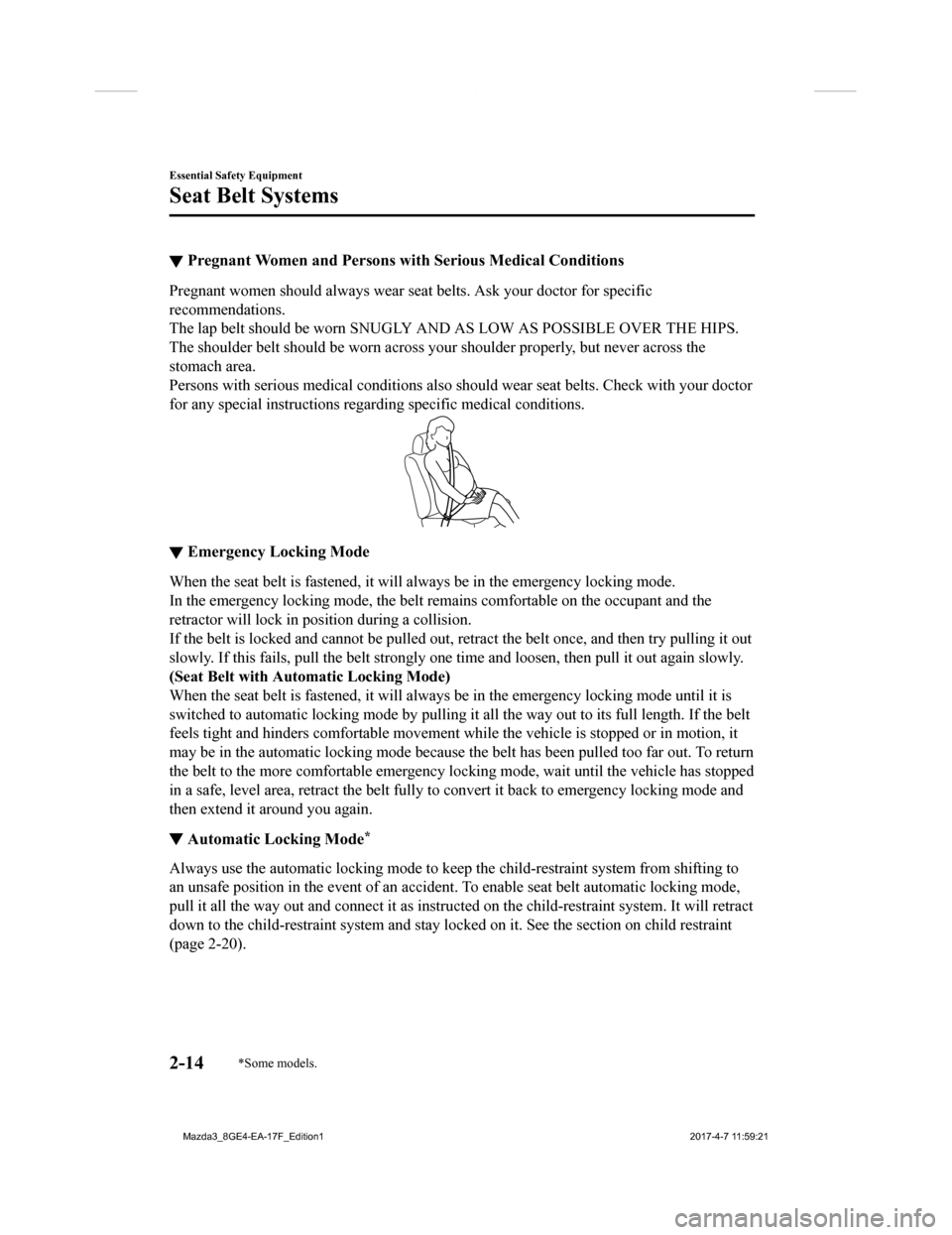
▼Pregnant Women and Persons with Serious Medical Conditions
Pregnant women should always wea
r seat belts. Ask your doctor for specific
recommendations.
The lap belt should be worn SNUGLY AND AS LOW AS POSSIBLE OVER THE HIPS.
The shoulder belt should be worn across your shoulder properly, but never across the
stomach area.
Persons with serious medical conditions also should wear seat b elts. Check with your doctor
for any special instructions regarding specific medical conditi ons.
▼Emergency Locking Mode
When the seat belt is fastened, it will always be in the emergency locking mode.
In the emergency locking mode, the belt remains comfortable on
the occupant and the
retractor will lock in pos ition during a collision.
If the belt is locked and cannot be pulled out, retract the bel t once, and then try pulling it out
slowly. If this fails, pull the belt strongly one time and loos en, then pull it out again slowly.
(Seat Belt with Autom atic Locking Mode)
When the seat belt is fastened, it will always be in the emergency locking mode until it is
switched to automatic locking mode by pulling it all the way ou t to its full length. If the belt
feels tight and hinders comforta ble movement while the vehicle is stopped or in motion, it
may be in the automatic locking mode because the belt has been pulled too far out. To return
the belt to the more comfortable emergency locking mode, wait u ntil the vehicle has stopped
in a safe, level area, retract t he belt fully to convert it back to emergency locking mode and
then extend it around you again.
▼ Automatic Locking Mode*
Always use the automatic locking mode to keep the child-restrai
nt system from shifting to
an unsafe position in the event of an accident. To enable seat belt automatic locking mode,
pull it all the way out and connect it as instructed on the chi ld-restraint system. It will retract
down to the child-restraint system and stay locked on it. See t he section on child restraint
(page 2-20).
Essential Safety Equipment
Seat Belt Systems
2-14*Some models.
Mazda3_8GE4-EA-17F_Edition1 2017-4-7 11:59:21
Page 29 of 624
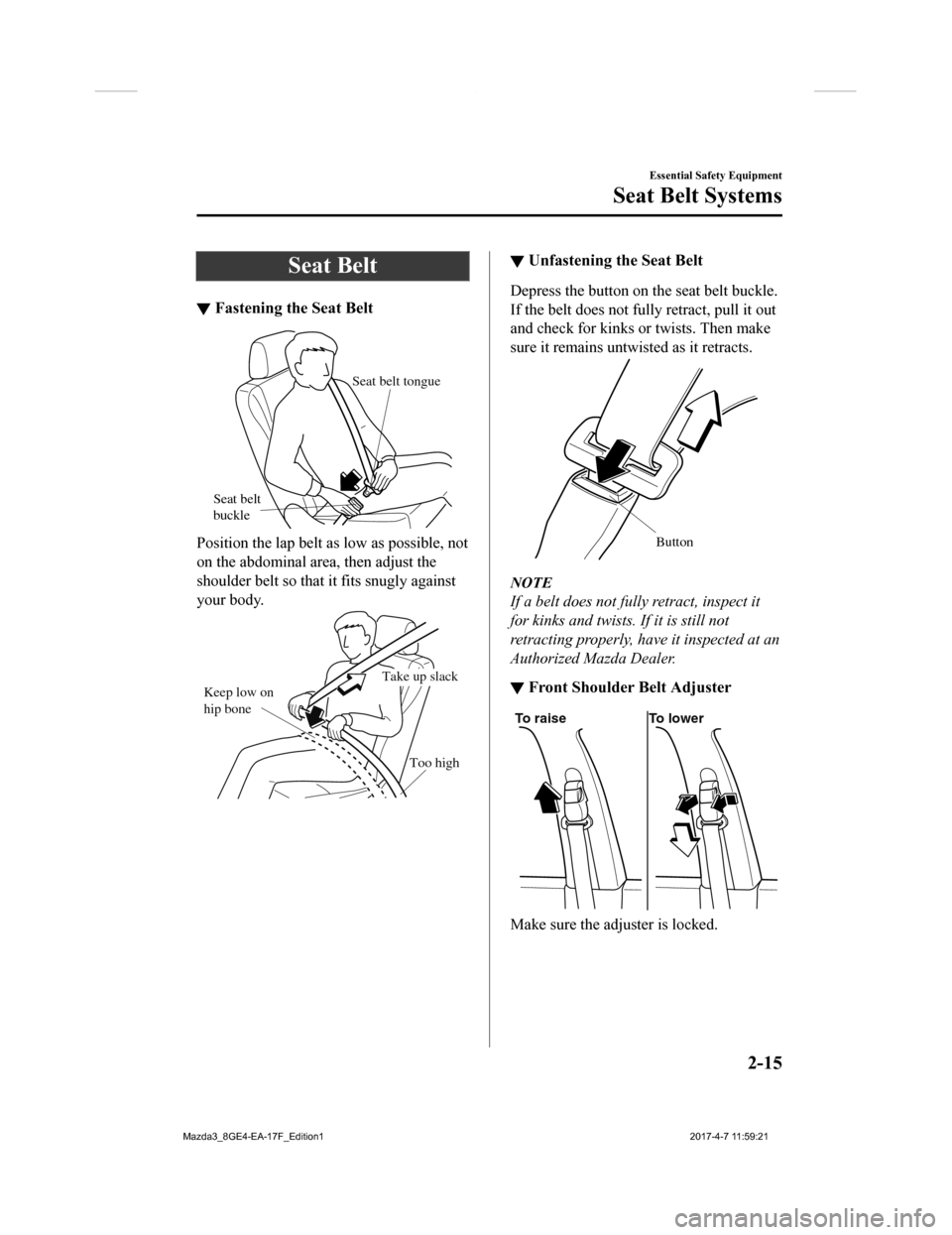
Seat Belt
▼Fastening the Seat Belt
Seat belt
buckle Seat belt tongue
Position the lap belt as low as possible, not
on the abdominal area, then adjust the
shoulder belt so that
it fits snugly against
your body.
Keep low on
hip bone
Too highTake up slack
▼Unfastening the Seat Belt
Depress the button on the seat belt buckle.
If the belt does not fully retract, pull it out
and check for kinks or twists. Then make
sure it remains untwisted as it retracts.
Button
NOTE
If a belt does not fully retract, inspect it
for kinks and twists. If it is still not
retracting properly, have it inspected at an
Authorized Mazda Dealer.
▼Front Shoulder Belt Adjuster
To raise
To lower
Make sure the adjuster is locked.
Essential Safety Equipment
Seat Belt Systems
2-15
Mazda3_8GE4-EA-17F_Edition1 2017-4-7 11:59:21
Page 30 of 624
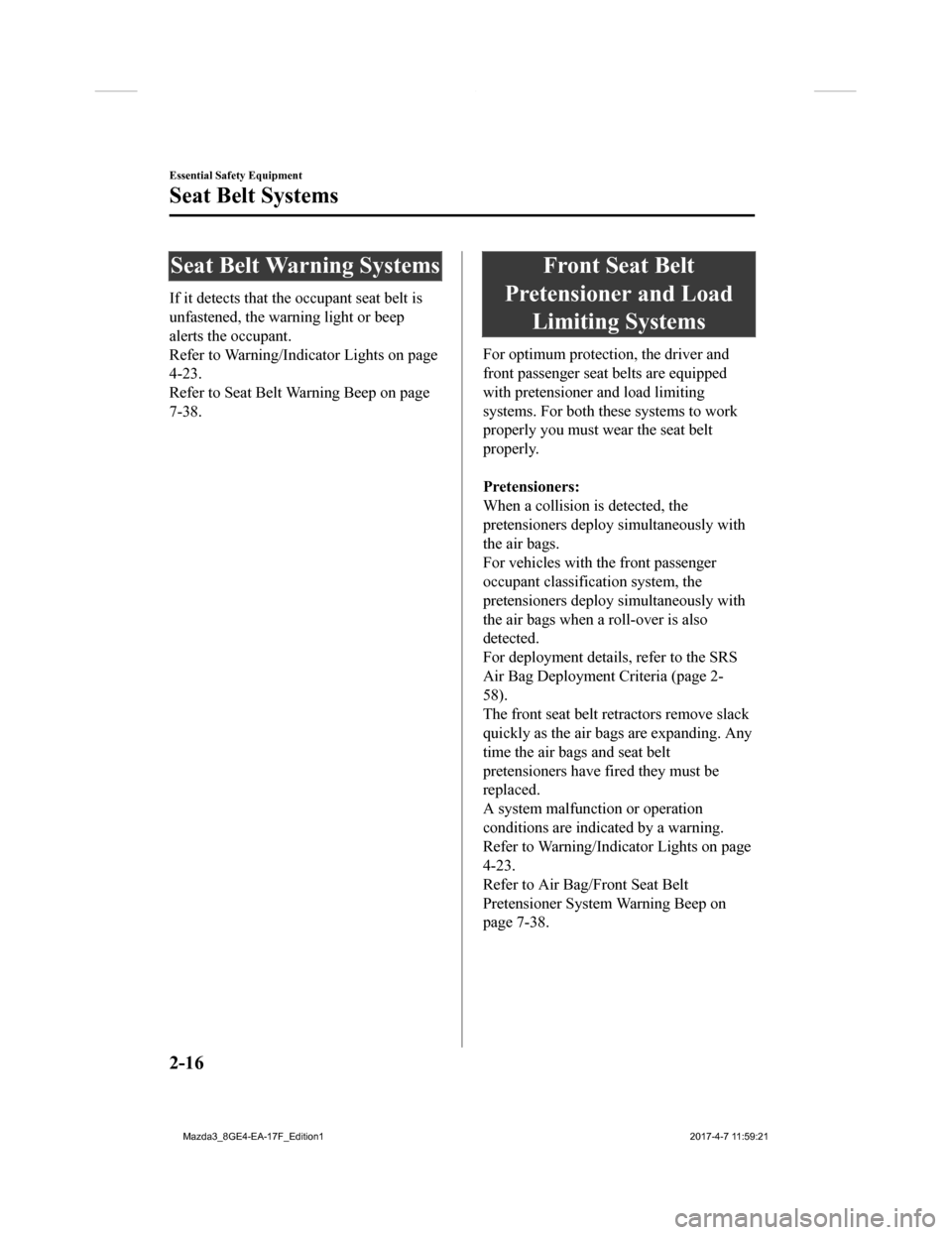
Seat Belt Warning Systems
If it detects that the occupant seat belt is
unfastened, the warning light or beep
alerts the occupant.
Refer to Warning/Indicator Lights on page
4-23.
Refer to Seat Belt Warning Beep on page
7-38.
Front Seat Belt
Pretensioner and Load Limiting Systems
For optimum protection, the driver and
front passenger seat belts are equipped
with pretensioner and load limiting
systems. For both these systems to work
properly you must wear the seat belt
properly.
Pretensioners:
When a collision is detected, the
pretensioners deploy simultaneously with
the air bags.
For vehicles with the front passenger
occupant classification system, the
pretensioners deploy simultaneously with
the air bags when a roll-over is also
detected.
For deployment details, refer to the SRS
Air Bag Deployment Criteria (page 2-
58).
The front seat belt retractors remove slack
quickly as the air bags are expanding. Any
time the air bags and seat belt
pretensioners have fired they must be
replaced.
A system malfunction or operation
conditions are indicated by a warning.
Refer to Warning/Indicator Lights on page
4-23.
Refer to Air Bag/Front Seat Belt
Pretensioner System Warning Beep on
page 7-38.
Essential Safety Equipment
Seat Belt Systems
2-16
Mazda3_8GE4-EA-17F_Edition1 2017-4-7 11:59:21